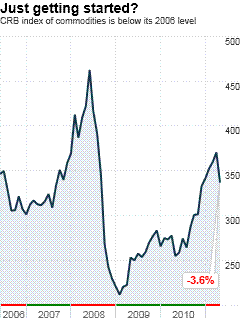大宗商品价格的涨势

|
卡尔尼本周一的演讲主要强调了加拿大在这个多变的世界中的角色,不过卡尔尼还单独谈到了石油、铜和谷物等产品的价格问题。 新兴经济体城市中产阶级的崛起,对很多大宗商品都产生了重大的影响。不过在衣食住行等各方面,主要新兴市场国家的消费水平仍然只是发达国家的零头。 要想追赶上发达国家的消费水平,这些新兴国家还有很长的路要走。在一段时间内,这些国家对商品的需求预计还将保持强劲。鉴于上世纪60年代的日本和80年代的韩国的经验,可以说在未来的几年里,亚洲新兴国家的能源和金属消耗量会水涨船高。 当然,最近大宗商品价格有所下降。如果在2011年剩下的时间里,经济复苏持续疲软,那么商品价格也许还会继续下降。此外随着时间的推移,供给将做出反应,使许多产品的价格出现下跌。不过下跌的速度未必会有我们所希望的那么快。(而石油的价格可能根本不会出现下跌,除非到时石油的价格本身已经比现在高出许多)。 不过如果你听了卡尔尼的话,再看看过去五年的商品价格指数(见右图),你就会明白,我们不应该过度沉迷于上个月的利好消息。 译者:朴成奎 |
Carney's speech Monday focused on Canada's role in a changing world, but it included this aside about the price of stuff like oil, copper and grains: The expanding urban middle class in emerging economies is having a major impact on a wide range of commodities. Whether it is travel, housing or protein, consumption levels in major emerging markets are currently fractions of those in advanced economies. With convergence still a long way off, the demand for commodities can be expected to remain robust for some time. Based on the experiences of Japan in the 1960s and Korea in the 1980s, emerging Asia's energy and metals intensities should gain momentum in coming years. Commodity prices have been falling lately, of course, and they may continue to do so as the economic recovery sputters through the balance of 2011. And over time there will be a supply response that will ease prices for many goods, if not necessarily as quickly as we might like (and perhaps not at all in the case of oil, except at much higher prices). But reading Carney's remarks – and looking at a commodity index chart covering the past five years (see right) – says we shouldn't get too used to the good news of the past month. |













